Crème brulee is a simple, yet elegant, decadent and impressive dessert! If you like classic crème caramel, then you will also LOVE this silky, creamy custard dessert, topped with a thin, crackly layer of caramel. This is the perfect crème brûlée recipe!
You can also make this crème brûlée recipe in a sous vide, for guaranteed and foolproof results!
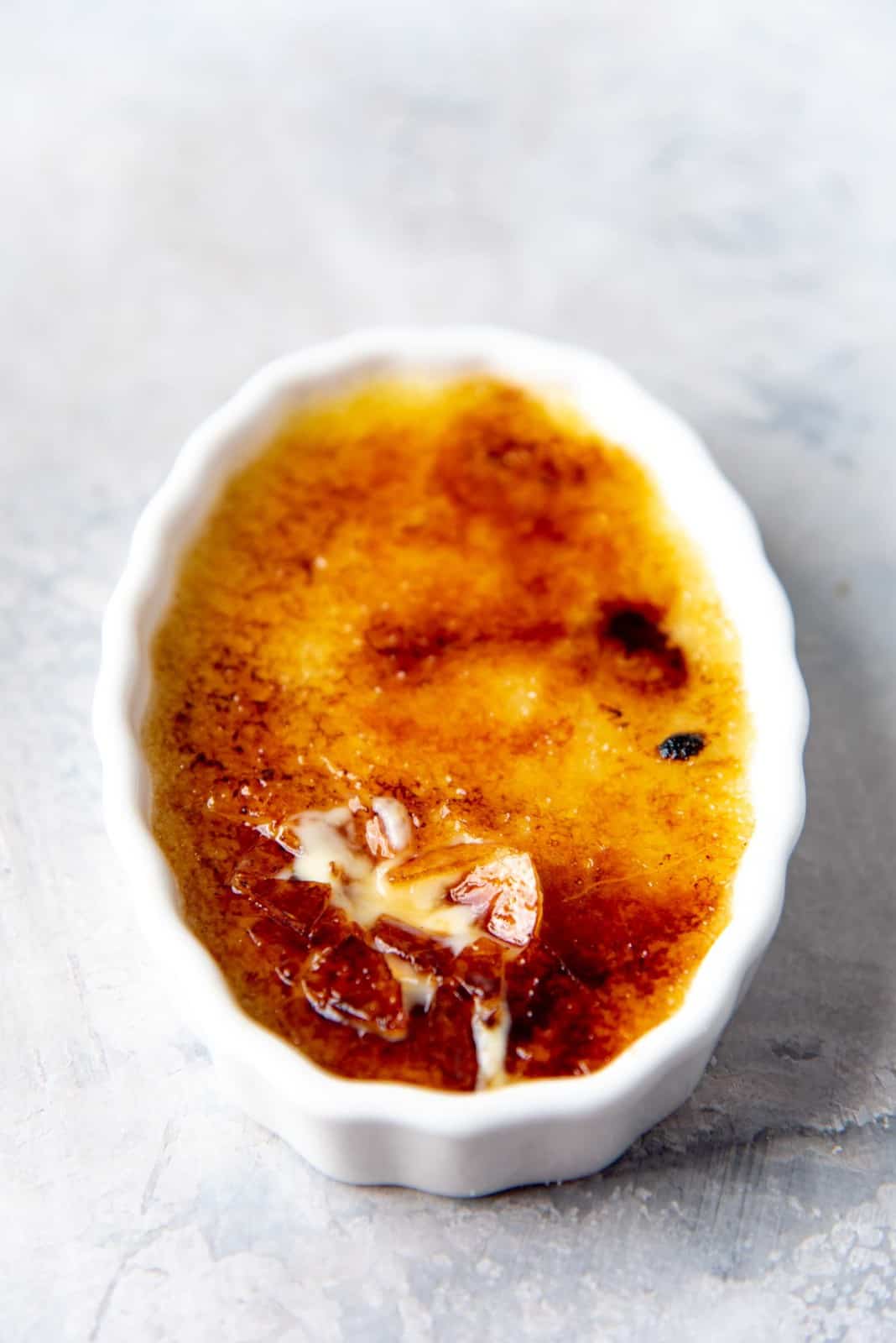
There’s not much to say about creme brulee, it’s one of the most well known French dessert recipes and a favorite for a lot of people. It’s a decadent and impressive dessert to serve at any party. And it’s so easy to make, although it feels like it should be more complicated… But it isn’t!
What is classic creme brulee?
Creme brulee translates to “burnt cream”. The cream itself isn’t really “burnt” though. Instead, this creamy custard dessert is topped with a thin, crackly layer of burnt caramel.
The most satisfying thing when eating creme brulee without a doubt is that initial crack when you hit the caramel surface with the back of your spoon, and expose that deliciously smooth, creamy custard underneath.
Creme brulee is a French dessert, and the classic version uses good quality vanilla to flavor the custard. Since vanilla is the main flavor, it’s important to use the good stuff (or the best stuff you have access to).
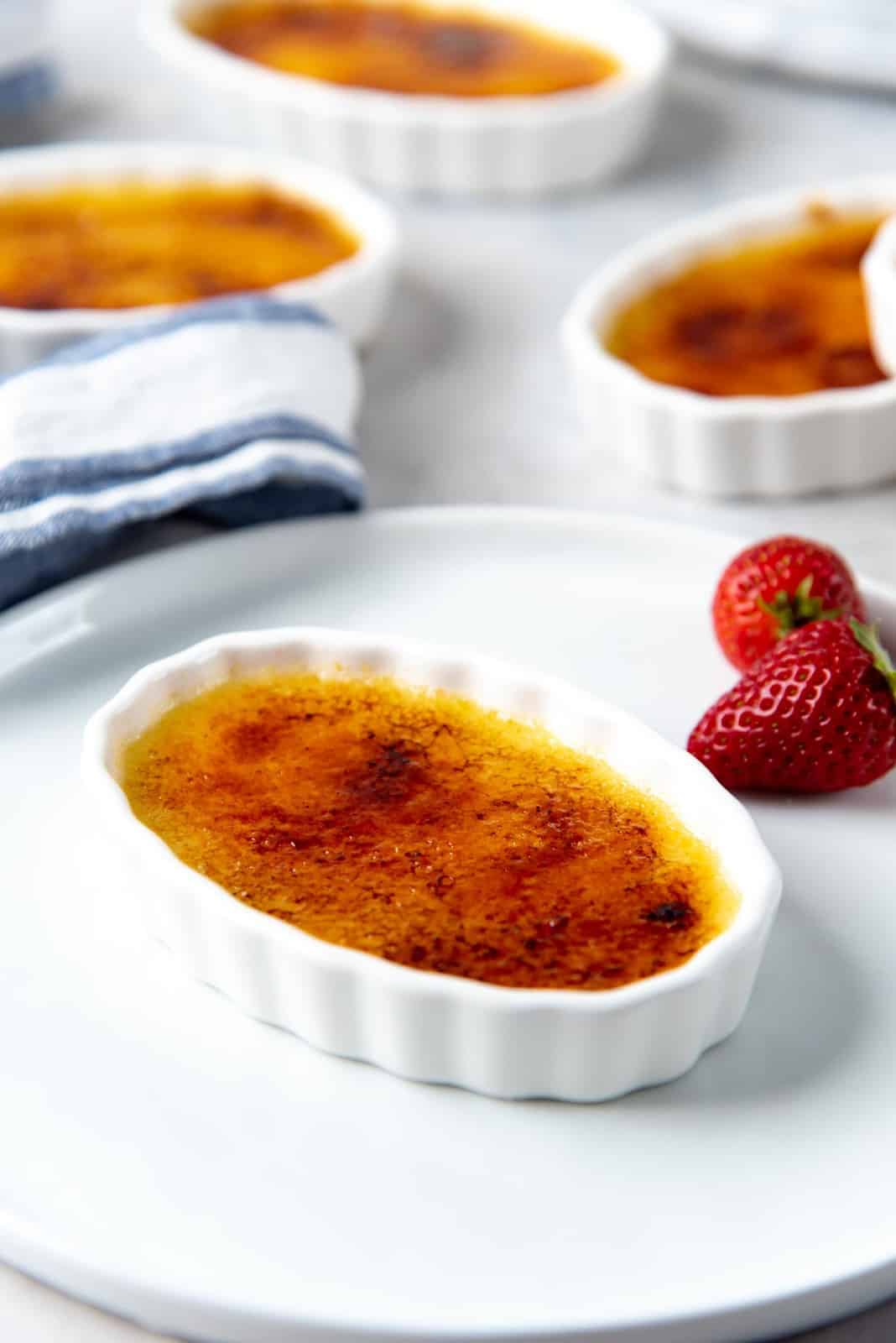
Why you’ll love this creme brulee recipe
- It’s a super simple recipe.
- They are individual-sized desserts, so perfect for dinner parties.
- You can make this ahead of time (but caramelize the sugar just before serving).
- Incredibly creamy and impressive dessert!
- I’ll be sharing TWO ways of caramelizing the sugar – WITH or WITHOUT a blow torch.
How to make Creme Brulee
Making creme brulee is easy. Usually the method involves mixing warmed cream with egg yolks, sugar and vanilla. Most recipes call for the cream to be heated up to a simmer. But is this necessary?
Do you need to heat the cream to make creme brulee?
Some people feel that heating the cream will “pre-cook” the eggs, keeping it more stable during the process of baking.
Honestly, I haven’t found this to be true. I have made creme brulee with heated cream and chilled cream and haven’t found a difference in the final baked creme brulee. Especially since they will be baked in a water bath, which helps regulate and temper the custard temperature.
You do not need to heat to a boil either. Older recipes often call for the cream to be boiled, so that it can be pasteurized. However this is not something we need to be worried about today, as cream is already pasteurized.
So why heat the cream at all?
If you’re using vanilla beans, heat is important to allow the beans to infuse the flavor into the cream.
Sugar will dissolve in warm cream faster than in cold cream.
Also a warmer creme brulee mix will cook faster (a difference of just a few minutes, but still).
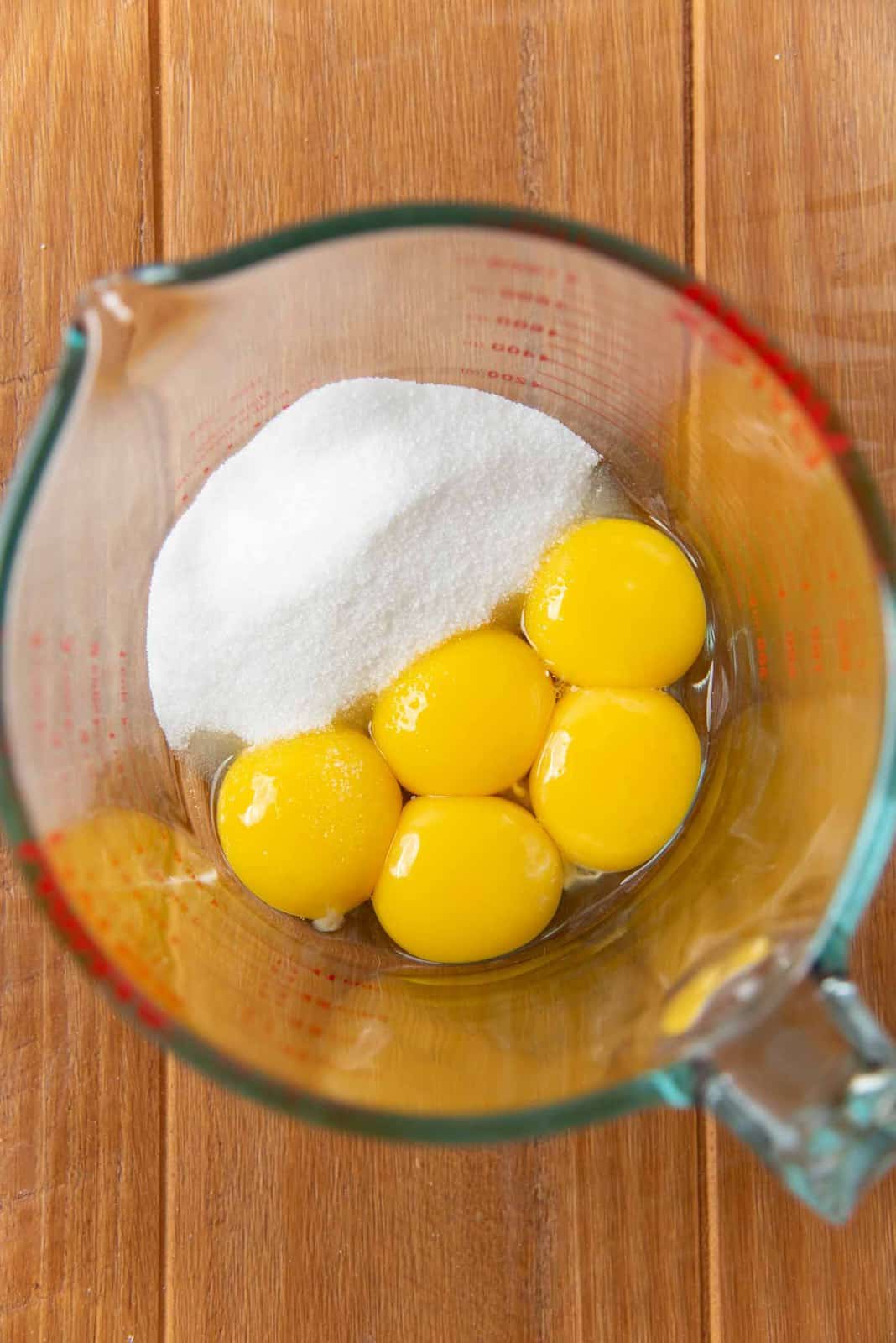
Prep the ingredients
Measure out the cream with measuring cups and place it in a saucepan.
If you’re using fresh vanilla beans, split the vanilla bean lengthwise and scrape out the caviar with the blunt side of a knife or a spoon.
Add the caviar to the cream along with the rest of the vanilla bean. Heat the cream over medium high heat and bring the cream to an almost simmer. If you’re using vanilla beans, then let the cream sit for about 5 minutes to infuse. Remove the vanilla bean pod.
While the cream is being heated, separate the eggs into yolks and egg whites. Place the egg yolks in a bowl and add the sugar and vanilla extract (or bean paste). Whisk the egg yolks, vanilla and sugar together until you have a smooth mix.
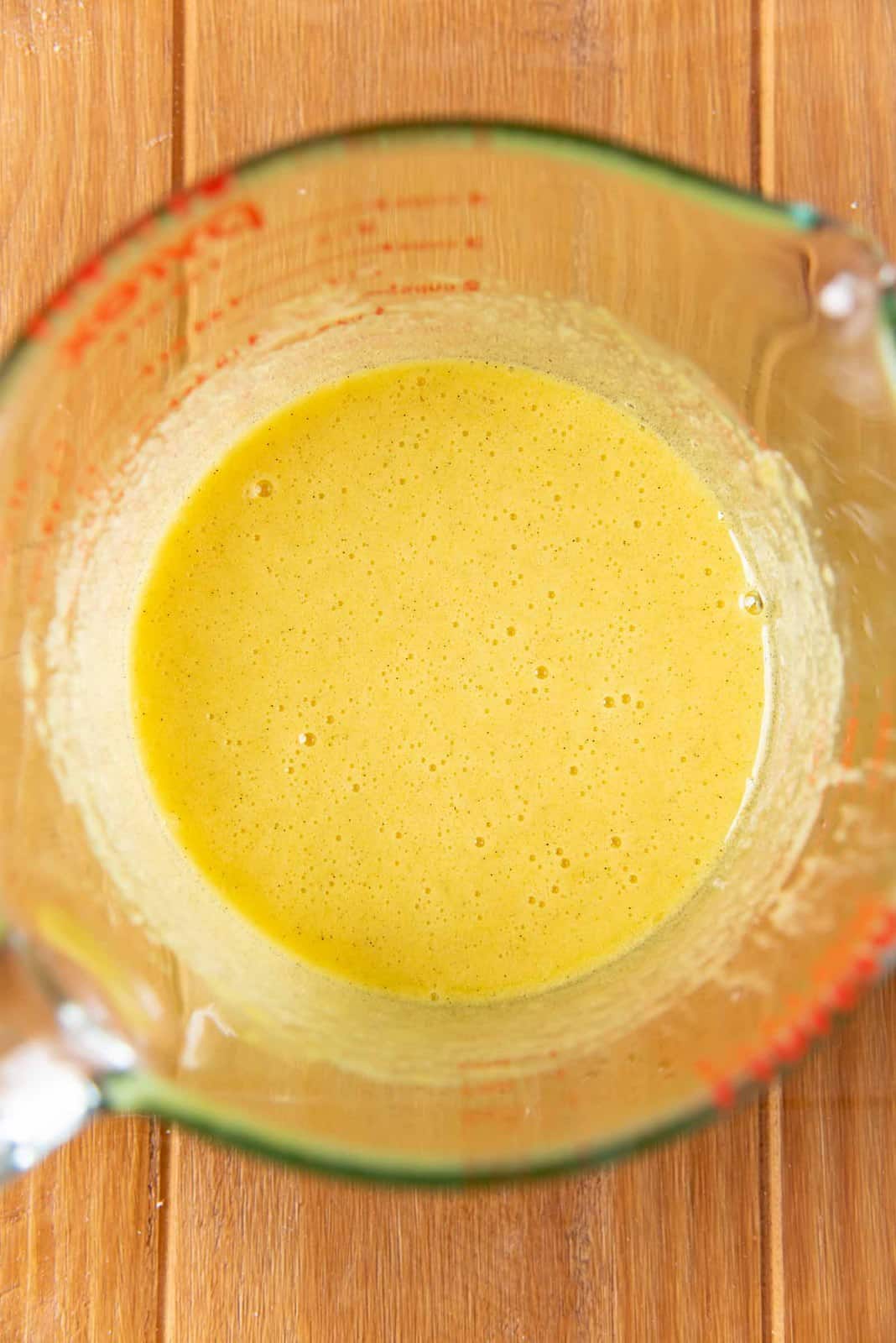
It’s important that you add sugar to the yolks and mix it for just a few minutes before adding it to the cream. This is because the sugar will start to cook the yolks as soon as they are mixed, and can change the consistency of the yolks.
Tempering the eggs
Since egg yolks can “scramble” at high temperatures, it’s important to mix the hot cream with the egg mixture the correct way.
Cream is added a little at a time to the egg mixture while whisking it constantly. This “tempering” will slowly heat up the egg yolks and the whisking prevents the yolks from coagulating.
The way I temper the eggs
I like to fold a thick paper towel or cloth napkin and place it on my counter. You can also use a non-stick mat instead.
Then I place the bowl with the yolks and sugar (whisked) on top of this napkin. This prevents the bowl from slipping. If your bowl is still slipping, then dampen the cloth napkin/paper towel, which should help keep the bowl in place.
Whisk the egg yolk mix with one hand and add the cream a little at a time, whisking the cream into the egg.
When about half of the cream has been whisked in, the eggs should be tempered. Then you can add the rest of the cream and whisk to combine.
I also like to add about 1 tbsp of bourbon whiskey at this point. But that’s just a personal preference of course. 😀
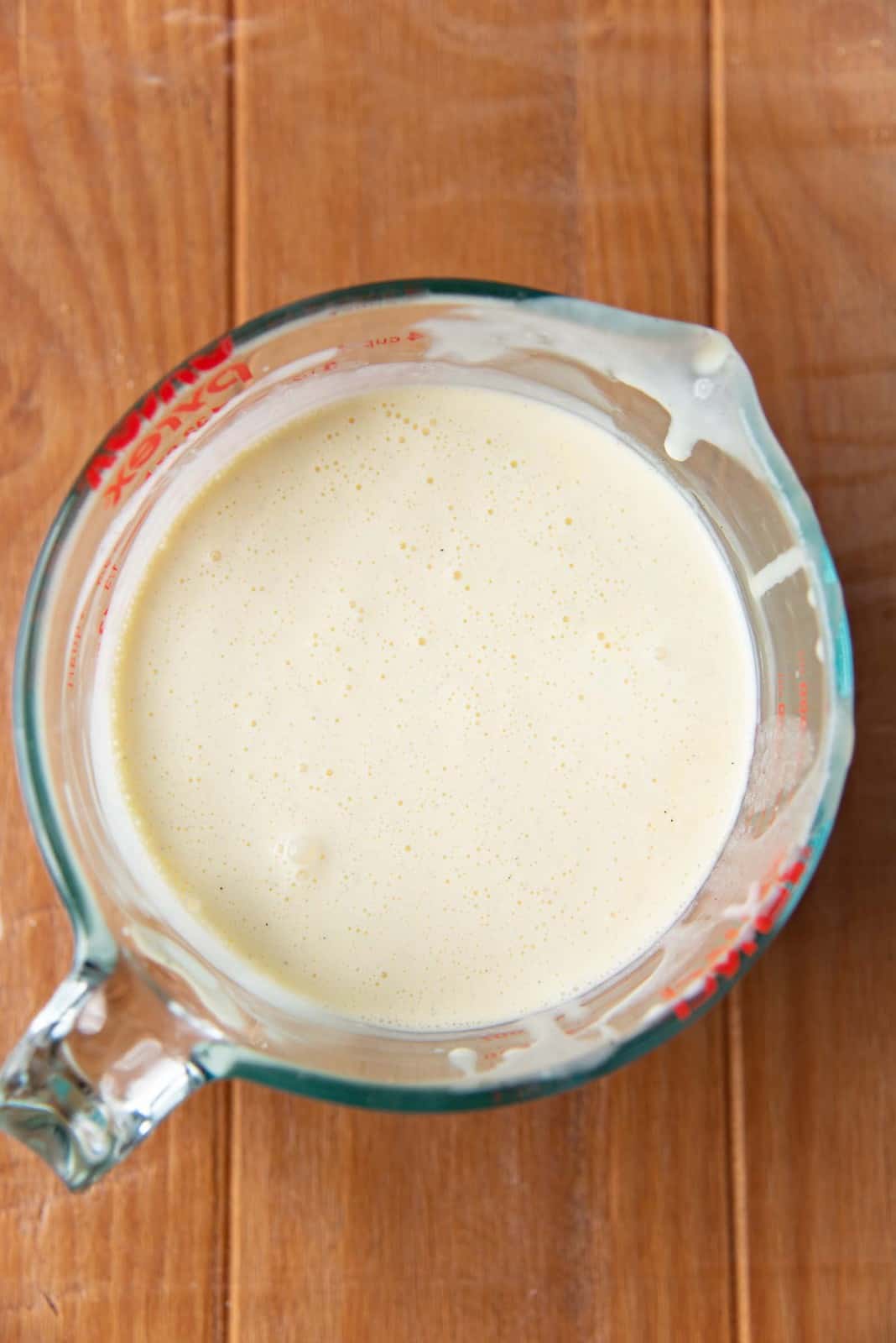
Portioning the custard
The next step is to portion the cream mixture into the individual baking dishes. Once you’ve poured them into the dishes, you might sometimes notice some bubbles on the surface. You can get rid of these bubbles with a toothpick, or by using a blow torch flame.
How to choose the right dishes for creme brulee
Creme brulee is an individual-sized dessert. They simply don’t work if made as a big dessert. At most, a portion should only serve two, ideally one.
As long as you have oven-safe dessert dishes (individual-sized baking dishes), you can use these to make creme brulee.
Equally portion out the creme brulee into your individual dishes. Having identical dishes, and filling them with equal amounts of the custard will ensure that they bake evenly, at the same time.
Classic creme brulee dishes
Classic creme brulee dishes are oven-safe shallow dishes. The custard layer will be thinner in these dishes, and therefore will cook faster in the oven as well.
And since the custard surface area is larger, there will be more of the crunchy caramel on top, with a shallow custard layer underneath.
Because of this, I prefer to add LESS SUGAR to my custard. The dishes below are the ones I used in the recipe here, but I’ve given instructions for ramekins as well below.
Ramekins
Oven-safe ramekins are great for creme brulee as well.
Creme brulee made in these dishes will have a smaller surface area for the caramel on top, with a thicker layer of custard underneath. So for these, I prefer to slightly increase the sugar amount in the custard.
These will also take longer to cook in the oven because of the thickness of the custard in the dish.
Baking the custards
These MUST be baked in a water bath.
Since eggs are sensitive to heat, high heat will cook the custard too quickly, and you’ll run the risk of overcooking the custard. This will leave you with a very curdled looking, lumpy custard. The opposite of silky smooth and creamy.
The water bath will help regulate the temperature, and heat the custard gently. So place the custards on a half sheet pan (for shallow dishes) or roasting pan (for deeper dishes like ramekins), and then add hot water until it reaches halfway up the sides of the dishes.
The bake time will also differ depending on the dish you are using. Flat, shallow dishes can take as little a 20 – 25 minutes, whereas ramekins can take over 30 minutes.
Once the custard bases are baked (with a very slight jiggle in the middle), let them cool down to room temperature. Then you can transfer the dishes into the fridge to chill (preferably overnight).
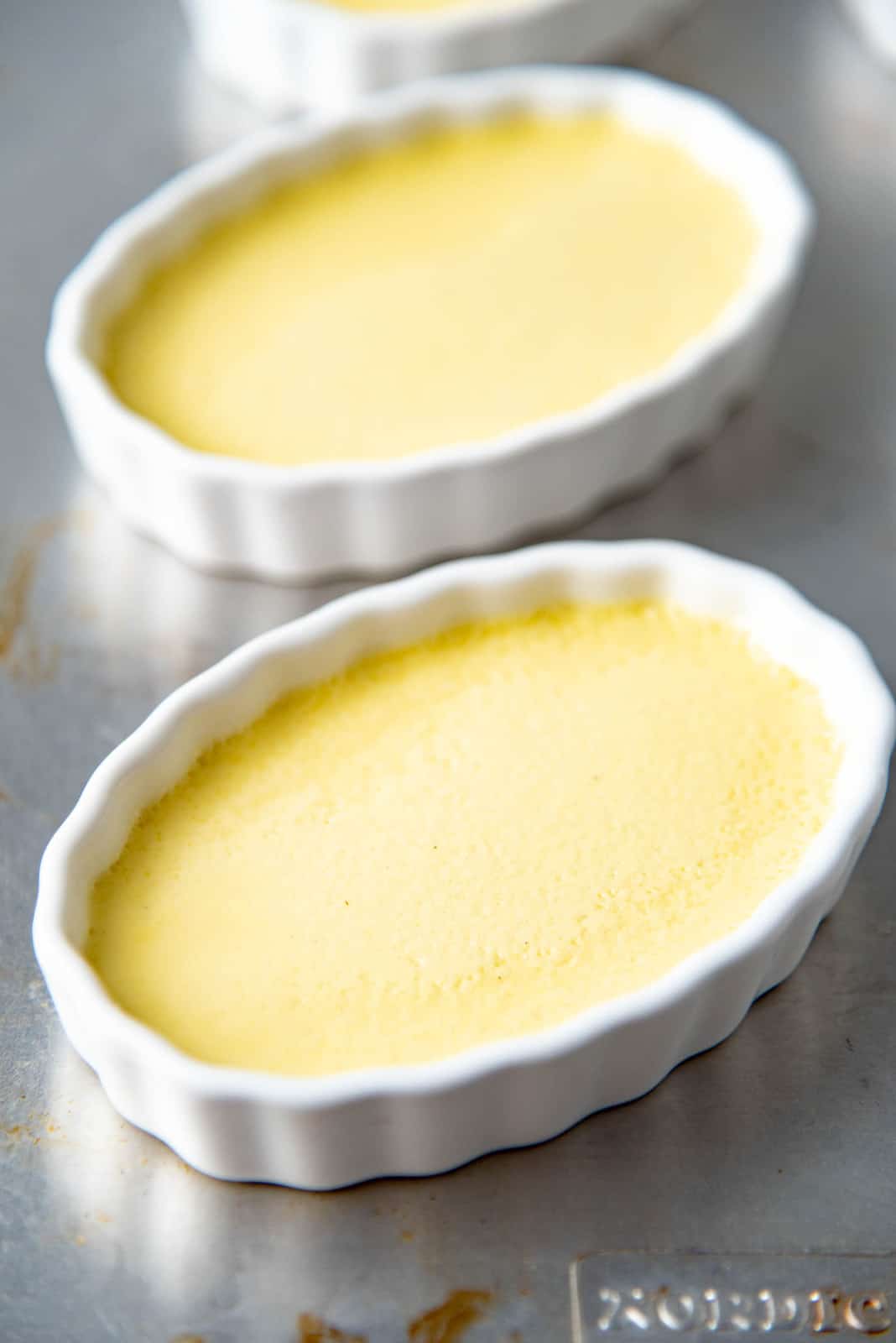
Serving the creme brulee
You should ONLY caramelize the sugar on the surface just before serving. If left for too long, the caramel layer can become soft and melt on the surface of the custard (resulting in soggy caramel!).
Here are two ways to create the caramelized surface for your creme bruee.
Blow torch method
Just before serving, sprinkle the surface of the chilled creme brulee with white sugar or raw sugar. Make sure the sugar layer is not too thick, and is even.
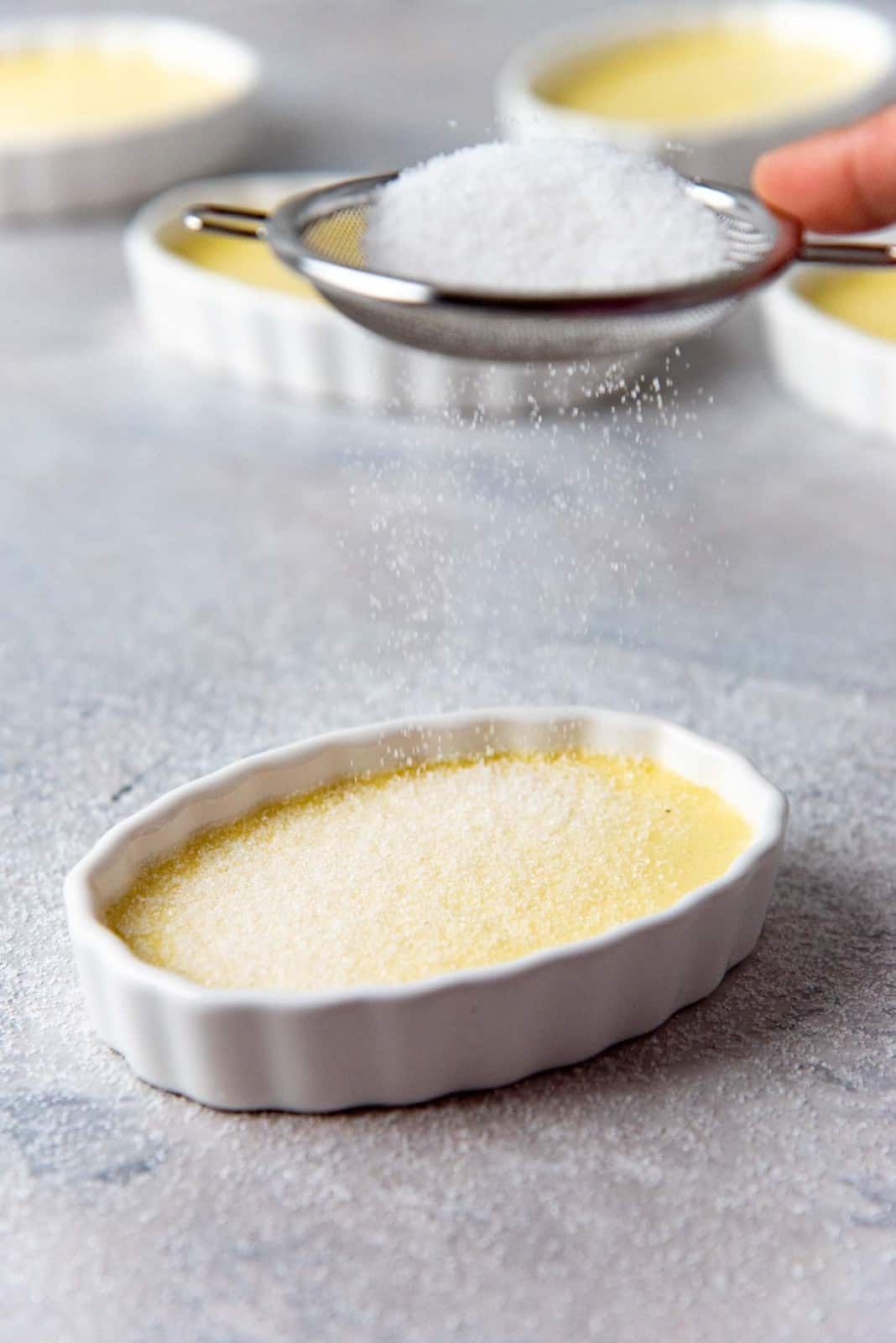
You can achieve the thinnest layer of sugar by “dusting” some sugar on top and then shake/rotate the dish to move the sugar over the surface and let it stick to the creamy custard. Then tip over the excess sugar. However, I prefer to just sprinkle the sugar on top.
With a blow torch, caramelize the sugar on top until it turns a gorgeous amber color. It’s completely OK if you burn bits of the sugar – after all it’s supposed to be “burnt cream”.
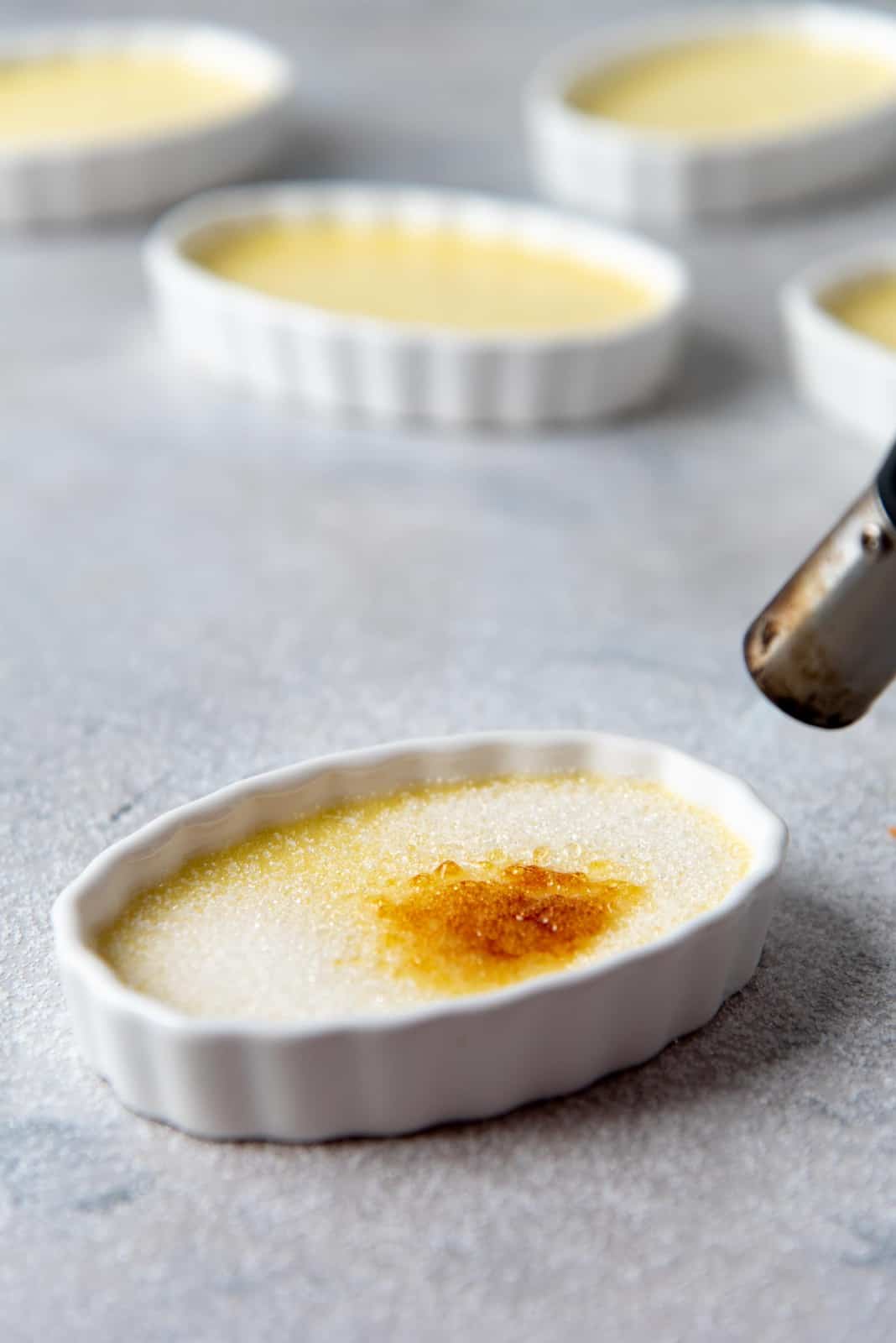
The sugar will bubble up as it caramelizes and that’s OK too. Once the surface is caramelized, let the sugar settle and cool down. Then it’s ready to be served!
If the sugar layer is too thick, you risk having to heat the sugar too long to caramelize it, and then end up heating the custard underneath. This will result in a creme brulee that is warm, and maybe even a little scrambled.
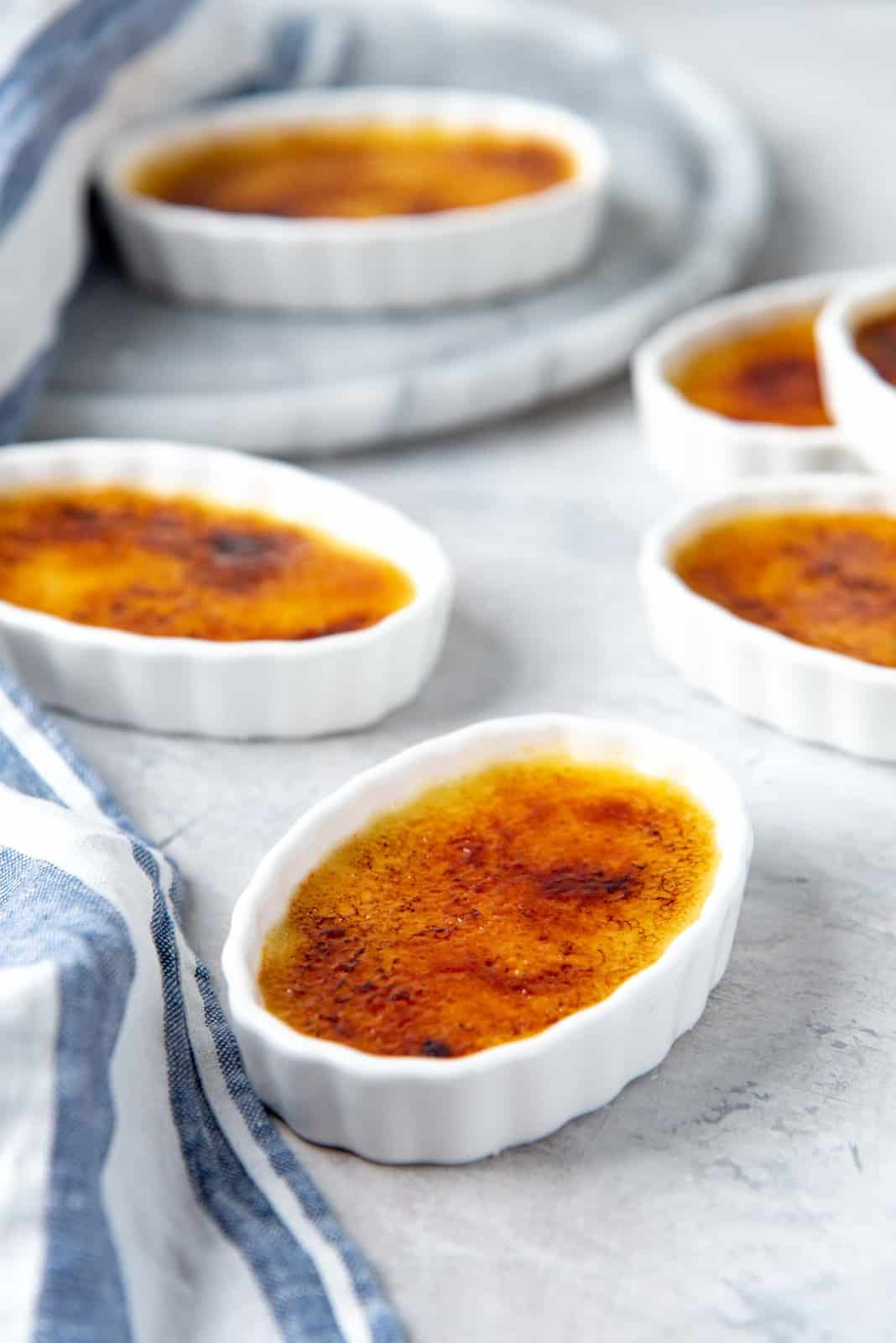
What if you don’t have a blow torch?
Some recipes call for the creme brulee dishes to be caramelized under a grill/broiler. I personally don’t like this, because it can heat up the creme brulee too.
How to create a caramel layer without a blow torch or broiler?
Easy! Make the caramel separately.
Take a small non-stick pan, and add about 1 – 2 tsp of sugar per portion of creme brulee.
Heat the pan over medium heat and gently shake the pan to distribute the sugar evenly to melt. Use a silicone spatula to occasionally mix the sugar to let it evenly caramelize in the pan.
When the sugar turns a golden/light amber in color, remove the pan from the heat. The caramel will continue to cook. Pour a little of the caramel on the custard, and immediately swirl to coat the surface with a thin layer of caramel.
Then let it sit so that the caramel can set. You’ll end up with a gorgeous, crackly caramel layer on top.
The only difference with this method is that you won’t have the uneven burnt spots, and it will also be shinier than the blow torch method. But it’ll taste just as delicious!
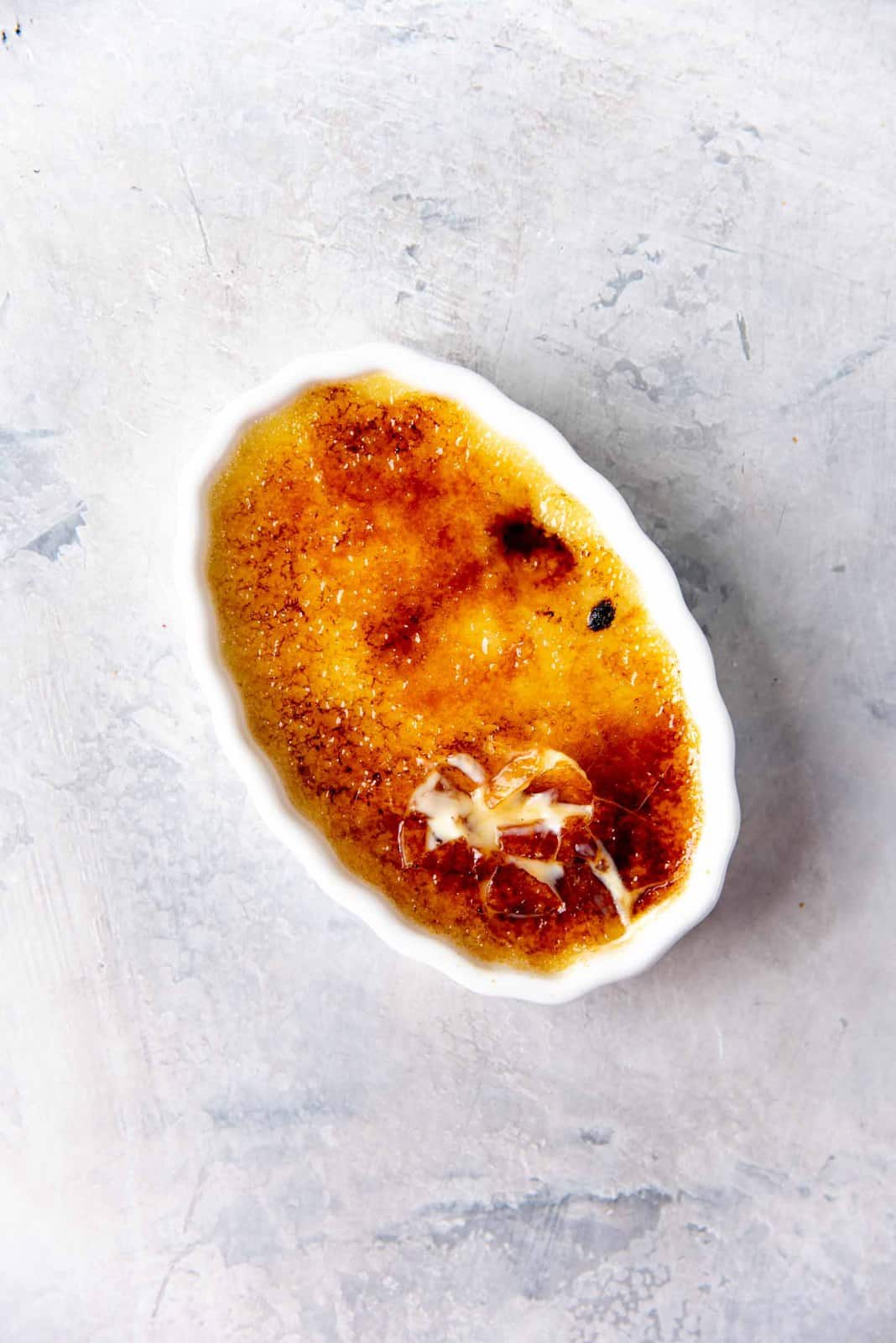
So go ahead and try making creme brulee at home. It’s so easy and incredibly delicious! This creamy, decadent dessert is also super addictive, so make a double batch for later! 🙂
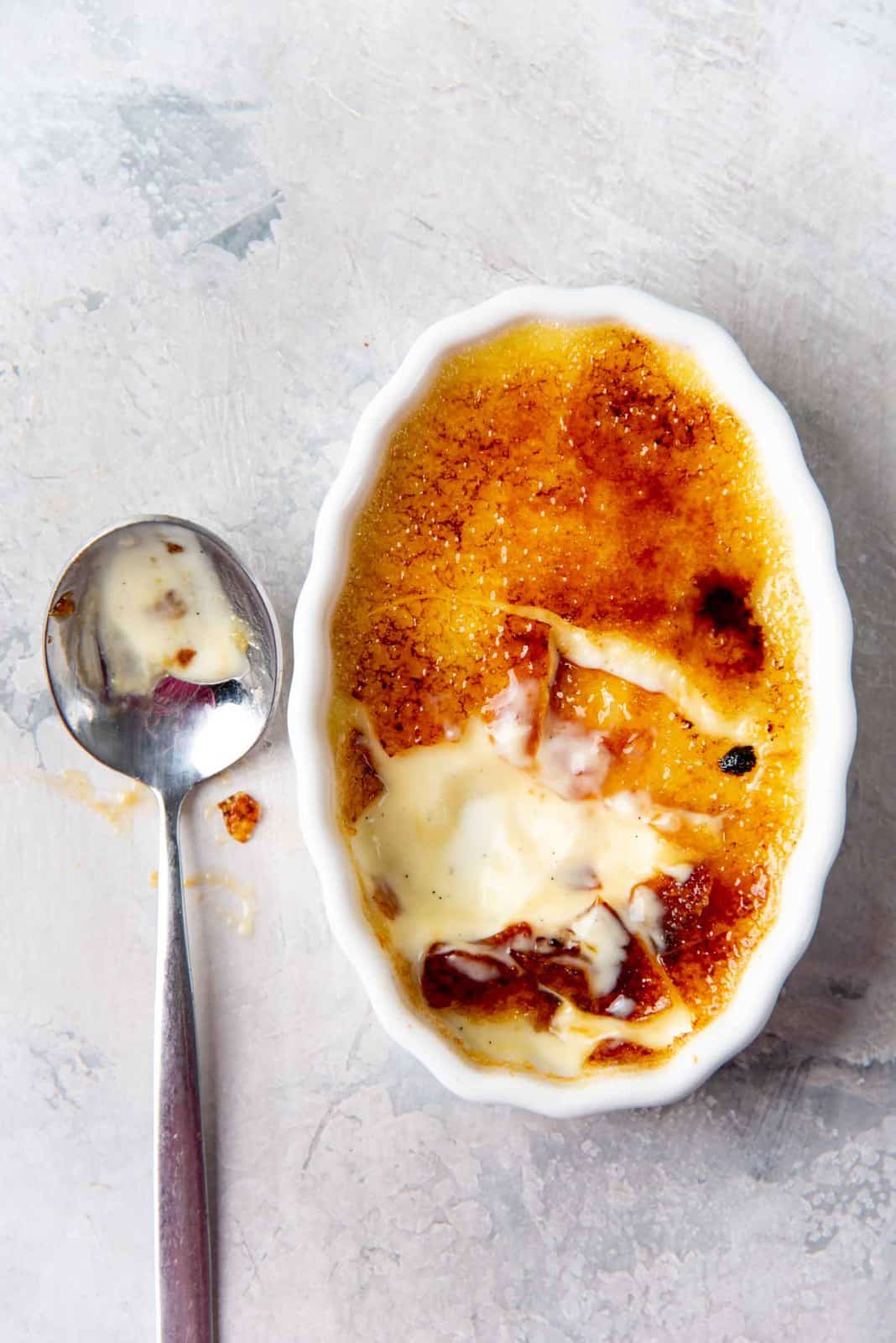
If you liked this recipe you may also like,
- Sri Lankan Watalappan (Coconut cardamom custard)
- Classic Creme Caramel
- Vanilla Pastry Cream
- Chocolate Pastry Cream
- Vanilla Pudding
- Chocolate Pudding
- Banana Pudding
Looking for more recipes?Sign up for my free recipe newsletter to get new recipes in your inbox each week! Find me sharing more inspiration on Pinterest and Instagram.
Classic Creme Brulee
Ingredients:
- 480 mL whipping cream 35% fat content
- 15 mL vanilla extract or 1 vanilla bean or 1 tbsp vanilla bean paste
- 5 egg yolks
- 50 - 100 g sugar use ¼ cup / 50 g if you are using shallow dishes, and ½ cup / 100 g for deeper ramekins
- Pinch of salt
- 30 mL bourbon optional
- Extra white sugar for caramelizing on top or raw sugar
Instructions:
Creme brulee custard base
- Place the cream in a saucepan.480 mL whipping cream
- If you’re using vanilla bean to flavor your custard base, split the vanilla bean lengthwise in half. Use the back of your knife to scrape out the caviar. Add the caviar and the vanilla bean pod to the cream. Whisk to combine.15 mL vanilla extract
- Heat the cream over medium / medium-high heat until the cream is steaming and just starts to simmer (not boiling).
- Let it sit for about 5 -10 minutes to allow the vanilla bean to infuse into the cream. It’s OK to leave it for longer as well.
- When the cream is infused with the vanilla bean, remove the vanilla bean pod from the cream. (If you want, you can strain the mix as well, but make sure the caviar stays in the cream).
- Place the egg yolks in a large bowl or jug. Add the sugar (make sure to add the right amount depending on the baking dishes), pinch of salt and bourbon (if using), and whisk together to form a paste.5 egg yolks, 50 - 100 g sugar, Pinch of salt, 30 mL bourbon
- Place the bowl with the egg mixture on a non-slipping surface (i.e. you can keep the bowl on top of a wet cloth napkin or thick paper towel). While whisking constantly, add the hot cream mix in small additions to the egg mixture. The eggs will have tempered enough when about half of the cream is added. Then add the rest of the cream and whisk gently to combine.
- The custard mixture may have some bubbles on the surface at this point. Cover and let it rest to allow the bubbles to subside. You can also gently stir to remove some of the bubbles.
- Preheat the oven to 325°F / 170°C.
- Place the individual baking dishes on a baking tray or roasting dish. Fill the baking dishes about ¾ of the way with the custard. SEE NOTES FOR MORE DETAILS.
- Place the tray/pan with the filled baking dishes in the preheated oven. Pour HOT WATER (the hottest water you can get from the tap should be fine) into the baking tray/pan until it reaches halfway up the individual baking dishes.
- Bake for 15 - 40 minutes (depending on the size of the baking dishes) until the custard reaches an internal temperature of about 175 - 180°F. The custards will be a little jiggly in the center and that’s OK. SEE NOTES FOR BAKING TIME VARIATIONS.
- Remove from the oven, and then remove the baking dishes from the water bath as well. Allow the custard to cool down to room temperature. Cover with plastic wrap and let them chill overnight.
Serving
- Before serving, caramelize the sugar on the surface of the creme brulee. There are two ways to do this.
Blow torch method
- Sprinkle a little sugar evenly over the surface of the custard. Make sure the sugar layer is not too thick so it can caramelize quickly.Extra white sugar for caramelizing on top
- If you used shallow and wide dishes, you may use slightly more sugar to cover the whole surface are. For smaller but deeper dishes, you can use less sugar on the surface.
- Use a blow torch to caramelize the sugar on the surface. The sugar should first melt, and start to bubble, and then turn from a light golden color to an amber color. Make sure to caramelize all the sugar without staying in one place for too long. Too much heat can curdle the custard underneath.
- Let the caramelized sugar cool down (just for a minute or two), and then the sugar should be hard to the touch. Serve immediately.
Stove top caramel method
- In a non-stick pan, add about 1 tbsp of white sugar per portion of creme brulee you will be serving. You may need more if the surface area of the serving dish is larger.
- Shake the pan to evenly distribute the sugar in one layer on the bottom of the pan.
- Heat the pan on medium heat and shake it occasionally to caramelize the sugar evenly. The sugar will first melt, and then start turning yellow and rapidly caramelize to an amber color. As the sugar starts to darken to a golden color, turn off the heat. The caramel will continue to cook and turn dark golden/amber in color.
- You may need another person to assist you in this step - As soon as the caramel turns dark golden in color, remove the pan from the heat and GENTLY pour about 1 tbsp of caramel over the custard. Have the other person IMMEDIATELY swirl the caramel over the entire surface of the custard in a thin even layer before it hardens.
- Return the pan to the stove that’s still warm (but switched off) in between if needed to keep the caramel liquid. You will need to eye ball the amount of caramel poured out to each dish, since you don’t want to use measuring spoons to measure it out.
- Repeat with the rest of the dishes. You may need to adjust the amount of sugar to add depending on how you go with the first one. This part needs to be done quickly, while the caramel is still fluid. The caramel hardens up quickly.
- When all the creme brulee dishes have been coated with caramel, and the caramel is hard to the touch, serve immediately.
Tips & Tricks
Note on which dishes to use
Classic creme brulee dishes - these are shallow but wide dishes. They can be oval, circle or square dishes. These may only have about a 1 - 2 cm deep custard base, and therefore should cook relatively quickly. About 15 minutes for smaller dishes, and 25 minutes for larger ones. I used 4 oz creme brulee dishes that were done in about 16 minutes. Ramekins - These will take longer because the custard layer is thicker, between 3 - 5 cm. Depending on the size and thickness of the custard, it can take between 25 - 45 minutes. I have used 4 oz ceramic ramekins that took about 30 minutes to cook. The custard is cooked when the internal temperature is about 175 - 180°F, or when it's set around the edges, but still slightly jiggly in the middle.Nutrition Information:
“This website provides approximate nutrition information for convenience and as a courtesy only. Nutrition data is gathered primarily from the USDA Food Composition Database, whenever available, or otherwise other online calculators.”
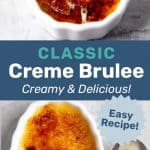
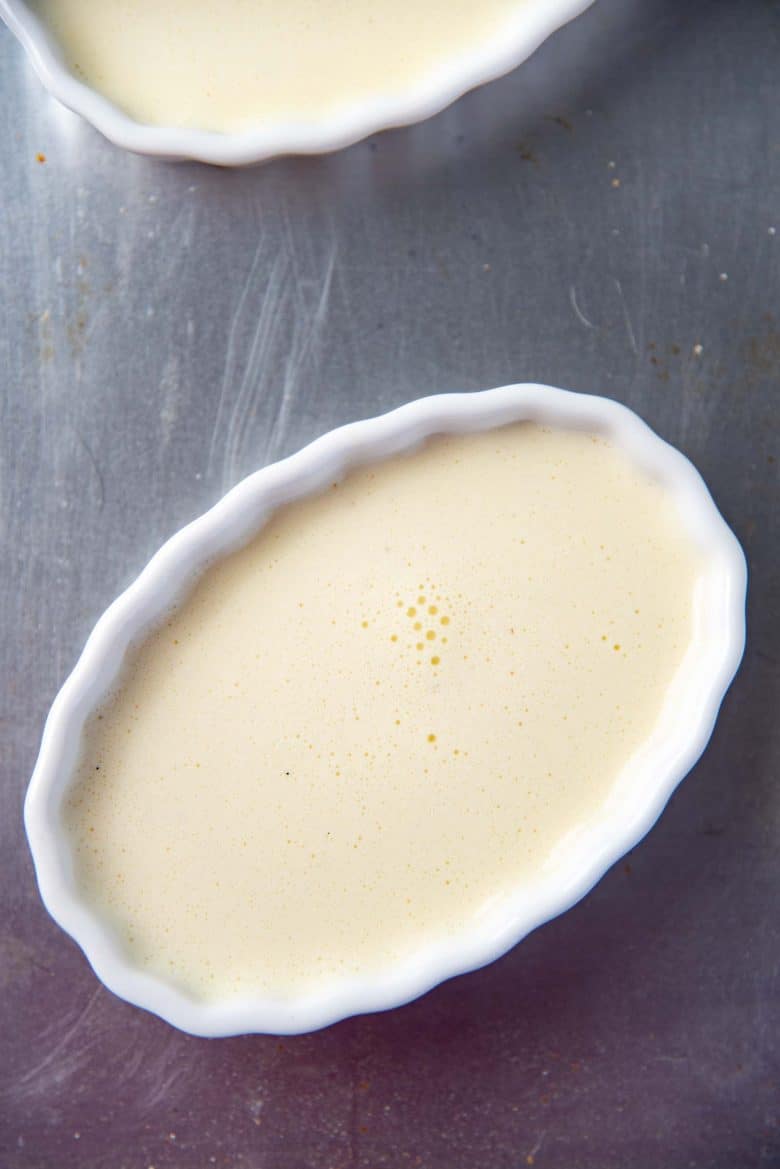
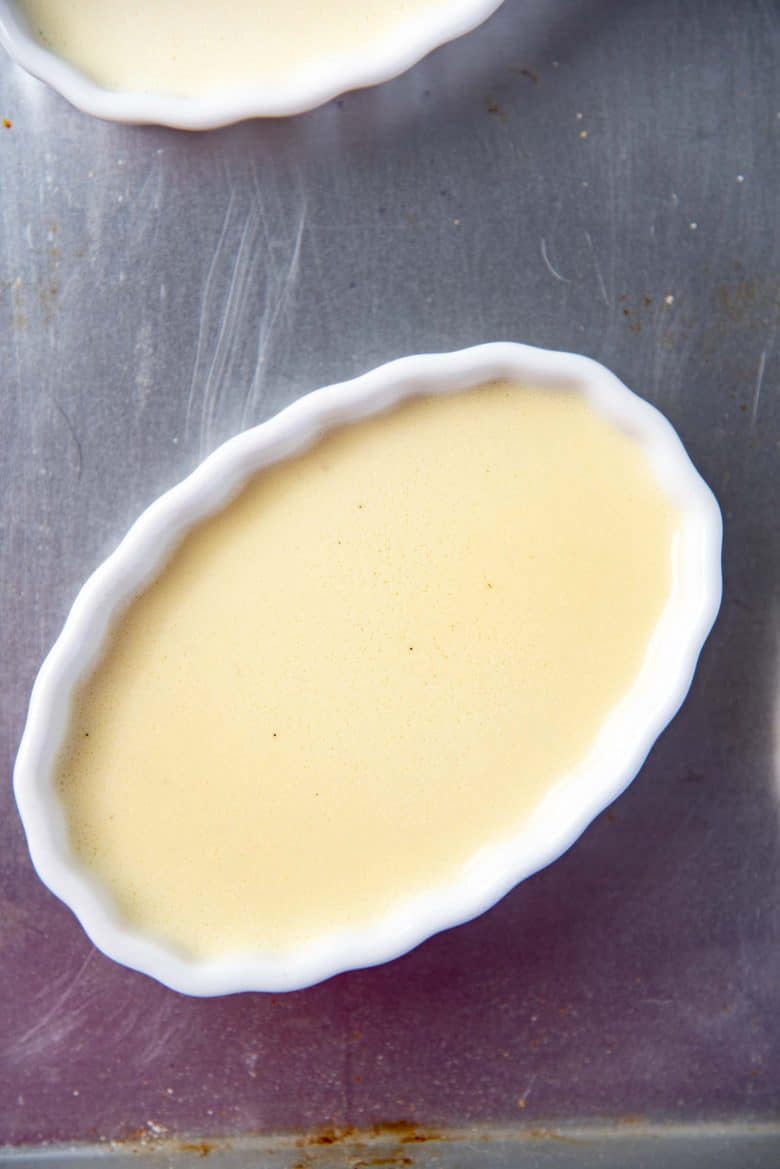
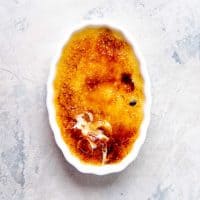
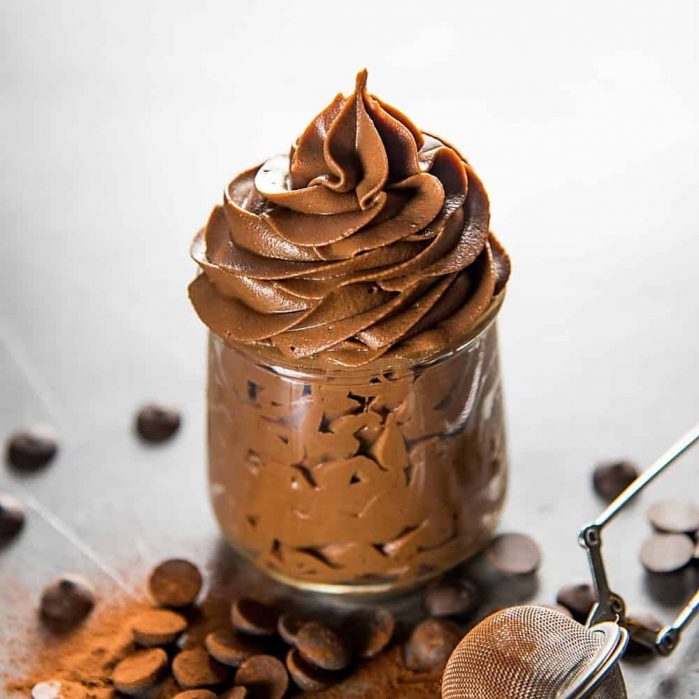
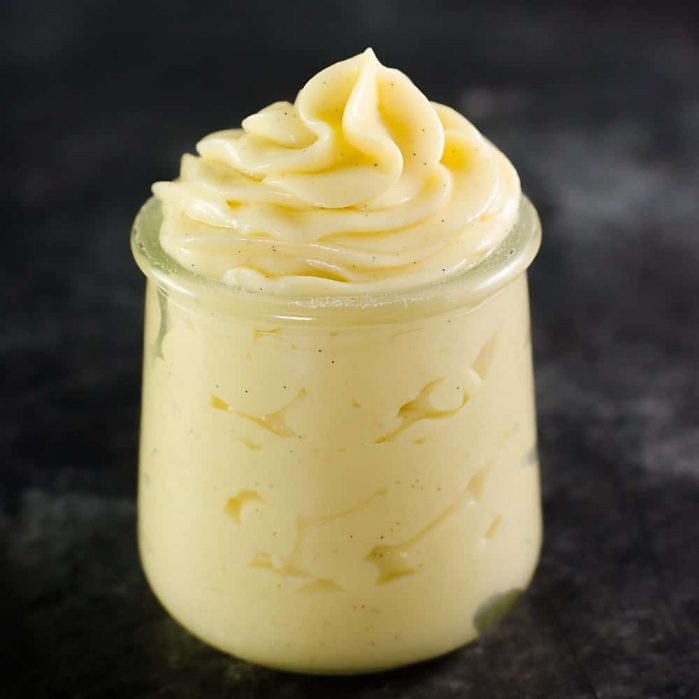
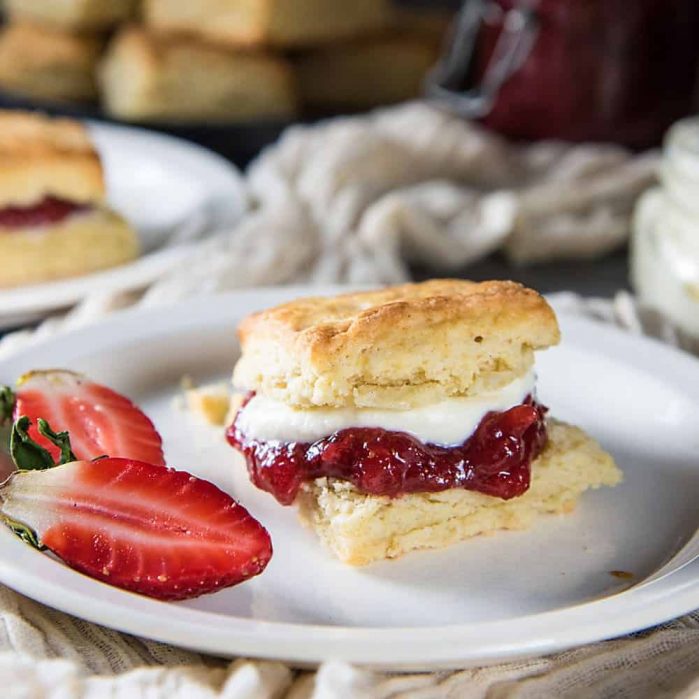
Paolo says
Could I add a couple tbs of unsweetened cocoa powder to make this a chocolate crème brûlée?
Paolo says
This recipe was better than the Ruth’s Chris crème brûlée I had on Father’s Day, thank you!!!
Vandana says
Hi. I’ve tried the recipe twice over. I live in india and used the cream we get here which is 25%fat. It didn’t set well. So this time I used the non dairy whipping cream and that didn’t set either. And was also all grainy. Any tips?
Dini says
Hi Vandana
If it’s not setting, it’s probably because the baking time isn’t enough. Every oven is different, and even baking dishes are different. It’s hard for me to be 100% certain.
A small difference in fat content shouldn’t make a difference either, although I haven’t used non dairy whipping cream.
I haven’t experienced a grainy texture in creme brulee before, but I know that grainy textures usually happen if the eggs are curdled (usually happens when the eggs are mixed with milk that is too hot). If there is any other additions in the creme bruless (something acidic), the milk can also curdle on its on.
Kristy says
I’ve tried numerous creme brûlée recipes but this is the best I’ve ever made. I made the recipe as directed, though I did strain the mix through a fine mesh strainer before pouring it into my ramekins. I used vanilla paste because vanilla beans are crazy expensive. This has become my new go to creme brûlée recipe. It’s a winner for sure!
Dini says
I’m so glad to hear that Kristy! 🙂 Thank you so much for letting me know!
Lindsay Grenz says
I recently got into baking and my brother requested creme brulee. It was so simple and such an easy recipe to follow. It was a rousing success. I definitely recommend this recipe!
Noelle says
This was such an easy and delicious recipe! Big hit at my house last night for dessert, making again soon!
Lisalia says
What gorgeous photos! So easy to make and absolutely delicious. Thanks for the step by step photos and instructions to refer to! So helpful.
Cheri R says
So delicious and easy!!!